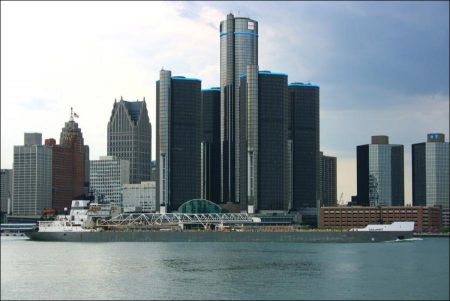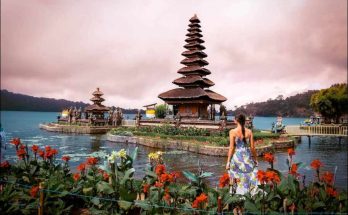The Cities of the Calumet — Gary, Hammond, East Chicago, Whiting – have in little more than two decades become one of the world’s greatest industrial centers. Perhaps nowhere else in the Nation is there such concentration of diversified industry in an area of similar size (70 square miles).
Lying in the most northwesterly county of Indiana, the Calumet area follows the curve of Lake Michigan for 16 miles. Through the region flow two branches of a sluggish river that the French called Calumet. A profusion of reeds used by the Indians for pipestems grew along this river so that the name Calumet is thought to have originated from the French chalumeau (little reed). Through usage calumet came to mean ‘pipe with a reed stem.’
The romance of the growth of this region has been publicized the world over, and this amazing exhibition of modern industry at work attracts thousands of visitors annually. No writer concerned with the urban development of America has been able to omit Gary from his consideration. Whether his interest has been sociological, economic, or industrial, Gary, and in fact the entire Calumet region, has lain squarely across his path.
In 1905 the total population of the Calumet region was 19,000. Gary did not exist, Whiting and East Chicago were little more than villages, and Hammond, oldest of the group, had a population of 12,000. In 1905 more than half of this area was swamp, swale, and sand dunes, uninhabited and uninviting. Today it presents a massing of four modern cities with a multiplicity of industries, a maze of paved motorways, and a huge network of railroad tracks.
Industry dominates the entire region. There are 175 major and minor factories, including giant steel and rail mills, cement plants, one of the largest soap-manufacturing factories in the country, oil refineries, and enormous electric generating units.
This industrial panorama is striking by day and beautiful by night. Broken only by three small parks, the 16-mile crescent of the lake shore, from the Illinois Line on the west to the eastern edge of Gary, is a continuous array of manufacturing plants. In sections of Hammond and East Chicago, factories hug the water front and sprawl southward into these cities. Over the entire district are the smoke of the steel mill, the smell of the oil refinery, and the glow of the blast furnace. Always there is the clang of forge, the roar of wheels, and the thunder of dumping slag.
Column after column of stacks pour forth steamy white or heavy black smoke. Giant steel towers supporting high-tension cables stride over the region. Great gas reservoirs move imperceptibly up and down in huge steel frameworks. Cranes, oil distilleries, collieries, and giant factories stand silhouetted against the sky. Hundreds of oil tanks, silver gray or oyster gray, dot the area like mammoth mushrooms.
Barrack-like buildings of gray corrugated iron blend into the monochrome. Freight engines weave in and out with long strings of cars. Great banks of coal lie waiting for blazing furnaces. Bridges lift over the ship canal so that steamers and ore boats may pass. Everywhere in the composite of movement and noise thousands of workers hurry in and out. The only variations in the whole smoky, busy picture are occasional administrative, laboratory, or hospital buildings of brick, surrounded by small landscaped plots.
At night, myriads of lights outline shafts, tanks, and framework. Flames from open-hearth furnaces light the sky for miles. Black smoke gathers into clouds. It was of this picture that Carl Sandburg wrote in Smoke and Steel:
Ears and noses of fire, gibbering gorilla arms of fire, gold mud pies, gold bird wings, red jackets riding purple mules, scarlet autocrats tumbling from the humps of camels, assassinated czars straddling vermilion balloons;
I saw then the fires flash one by one: good-by: then smoke, smoke… Realizing that it is without the background of age, the Calumet region exploits its industrial pre-eminence. Visitors are told of the complete topographical transformation necessary before either house or factory could be built. Building was an engineering feat that involved all the new methods in wet excavation, drainage, building caissons and floating foundations, and ‘making land.’
Residents draw attention to the fact that this area was the birthplace of refrigeration for the transportation of dressed meat, of largescale utilization of by-products, and of the use of electricity as driving power in a large steel mill. They point to the crude oil pipe line from the mid-continental oil fields which has its northern terminal here.
They tell visitors that some of the longest bridges in the world, steel rails, gasoline, oil, antifreeze compound, and steel frames and tops for automobiles are manufactured here as well as cement for the highways upon which automobiles are driven. The show places are the massive industrial plants. Instead of a museum the stranger is shown a bridge spanning 67 railroad tracks or an insect farm where bedbugs, flies, and roaches are bred scientifically to test the efficiency of insect sprays.
In development this region is only as old as its oldest industry, but for those who look beneath the surface of the present there is the echo of things past. Marquette and Louis Joliet passed through here in 1673 and for an unrecorded period it was a Potawatomi hunting ground. Later, the flags of France, Great Britain, and the United States waved in succession over these dunes and swamplands.
The Cities of the Calumet are an industrial and geographical unit. Their city limits are contiguous. Physically they merge so completely that those who have lived here for 30 years often do not know where the city limits are. Many of the industries are related and in some cases interdependent. Highway, park, and city planning is done in co-operation with the Chicago Regional Planning Commission. However, socially and municipally, the cities are separate, each with its own residential districts, schools, civic buildings, and park systems. Each is an administrative entity and each has a distinctive social structure.
Visits: 151



